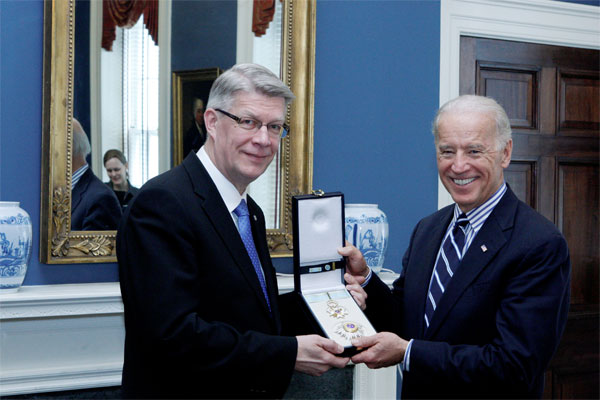Jānis Kurelis died Dec. 5, 1954, in Chicago. He was 72 years old and had bladder cancer, which he suffered with for nearly two years. His death certificate listed Kurelis’s occupation as a retired general in the Latvian army.
When Latvian officials come to Chicago in May for the NATO defense alliance summit, they should consider paying their respects to Kurelis.
A few episodes of the general’s military career should be noted.
During World War I, Kurelis was a lieutenant colonel in the 5th Latvian Riflemen Battalion. At the end of the war he, along with over 70 officers and 1,000 soldiers, found themselves in Vladivostok, Russia. Kurelis, other military officers and local Latvian civic leaders formed the Siberia and Ural Latvian National Council. An immediate outgrowth was also the formation of the Imanta Regiment. This was all done under the auspices and support of the local French mission and France’s embassy in China. Kurelis allied himself with a western power searching for a “third way” out of a precarious situation.
In return for France’s support, the Imanta regiment escorted military transports and performed policing functions. The regiment wore French uniforms with the addition of Latvian national colors. Instruction and communications were in Latvian. A commission was created to develop Latvian language military nomenclature. In February 1920, Vladivostok fell to the Bolsheviks. Latvia’s nascent Foreign Affairs Ministry arranged for the evacuation of the regiment with the assistance of Britain and France. Three ships during a six-month period left Vladivostok for the long journey back to Latvia. Later Latvia was billed and paid 8,500,017 francs and 130,000 pounds sterling for services rendered.
Kurelis was recalled to Latvia in September 1919. He served in various headquarters and Defense Ministry positions during the War of Independence. This conflict was chock full of shifting alliances, intrigues, misadventures, miscalculations and, more generally, simple chaos. During one period three separate governments, with significant military resources, claimed legitimate rule over the country. Latvia gained independence through grit, determination, patience, political maneuvering and good fortune. Critical assistance from France and Britain was leveraged against weakened German and Russian forces. During the defense of Rīga in 1919, peacekeeping naval ships from France and Britain turned their artillery guns against an attacking formation of Germans and monarchist Russians, known as the West Russian Army or Bermontians. The Latvian Army was then able to counterattack and eventually defeat this enemy and turn its sights eastward. With help from Poland, Soviet Russian forces were expelled from Latvia followed by a peace treaty in August 1920. Amazingly, Latvia slipped the leash.
In order to gain western support Latvia needed to demonstrate an unambiguous commitment to the cause of independence. This was done on the international stage by Zigfrīds Meierovics, the nation’s first foreign minister. Among other accomplishments, he secured British recognition of Latvia’s sovereignty a full week before a formal declaration of independence. Latvia also needed a credible national army.
From 1922 until 1940, when he reached mandatory retirement age, Kurelis served as commander of the army’s Technical Division. He was promoted to general in 1925. Like many other retired military officers, he was not subject to arrest immediately after the Soviet occupation of June 1940. The first wave of repressions was directed at active duty personnel, among many other groups of citizens. During the German occupation, which began a year later, he was the director of a security guard firm. The firm employed disabled persons to check locked doors and otherwise secure buildings.
In 1943 the Germans allowed the reestablishment of the paramilitary Aizsargi (Protectors) organization, which was originally created after Latvia proclaimed independence as a volunteer formation with both policing and military functions. Kurelis joined the 5th Rīga regiment. In September 1944, the Kurelis-led group left Rīga for Kurzeme in western Latvia. German forces were retreating and Soviet forces re-entered a virtually undefended Rīga on Oct. 13, 1944.
That German forces were retreating was not a surprise to the Latvian Central Council (LCC). This group was formed in August 1943 to coordinate pro-independence Latvian resistance during German occupation. In March 1944, the LCC promulgated a political manifesto that was ostensibly addressed as a memorandum to Gen. Rūdolfs Bangerskis, the inspector general of the German-created Latvian Legion. The title was more ministerial, as he did not exercise command authority. The document begins: “The enemy from the east is once again menacingly approaching Latvian territory”. It called for the proclamation of reestablished independence and renewal of the constitution and national army. The manifesto had an eclectic list of 189 signatories, including eight retired generals, one Lutheran archbishop, one Roman Catholic bishop, former politicians, government officials, academics, poets, literary figures, businessmen and others. Kurelis, who was head of the Council’s military commission was also a signatory.
The LCC’s practical activity revolved around creating a bridge to the west through Sweden. The LCC organized boats to transport refugees and move information back and forth. The group attempted to coordinate its activities with Latvia’s prewar embassy in Stockholm, which was still legally recognized and functioning. They maintained periodic radio contact with Swedish authorities. The LCC also published an underground newsletter.
Many LCC members were arrested by the Gestapo, including Konstantīns Čakste, the son of Latvia’s first president. The circumstances of his death are not completely clear, but it appears he died in February 1945 either in or near the Lauenburg or Stutthof concentration camps.
By late 1944 the ranks of the Kurelis group (popularly known as the Kurelians) swelled to 3,000 men. Serious external and internal problems developed. German authorities were becoming increasingly wary of the motives of the Kurelians. Also, the group was being flooded with deserters from the primarily conscript-based Latvian Legion. Within the group, discipline problems and divergent views among officers were prevalent.
The discipline problems and divergent opinions had much to do with what the Kurelians were trying to accomplish. The goal was clear: reestablishing Latvia’s independence. How to get there was completely unclear and any strategy revolved around a 1919 solution: Assistance from the west would be leveraged against weakened German and Russian forces and Latvia would slip the leash. Latvia needed a national army to demonstrate the true will of its people to western countries. The Kurelians primarily wore Latvian army or Aizsargi uniforms. They considered themselves the core of a reestablished national army.
They prepared for German defeat by trying to stay out of the Germans’ way. What the end-game was is simply unclear. Some possibilities include guerrilla warfare against the Soviets or an organized seaborne retreat to Sweden. The Latvian Legion’s 19th Division was almost entirely in Kurzeme and could, when circumstances allowed, defect en masse. Looming in the background was hoped-for intercession by Britain, Sweden or the United States.
Beginning in October 1944, the Germans increasingly were making demands and trying to rein in Kurelis. Deserters needed to be turned over, German direct and complete control established and all Kurelians identified. SS Lt. Gen. Friedrich Jeckeln took part in some of the ongoing meetings. Jeckeln controlled all Nazi forces in Latvia and is closely associated with the most horrific crimes perpetrated during German occupation, particularly against Latvia’s Jewish community. Jeckeln made some suggestion that Germany would agree to Latvian independence after the war and Kurelis asked to see it in writing. In response to German demands, Kurelis’s Chief-of-Staff Capt. Krišs Upelnieks created a list of 500 military personnel, which was an obvious undercount.
Deserters need to be understood in context. Elements of the Latvian Legion’s 15th Division, still in Kurzeme, were being redeployed to Germany. Some of these soldiers wanted to remain on Latvian soil, while deserting 19th Division soldiers probably joined the Kurelians for either patriotic or other reasons.
The officers in the group reached a consensus to avoid any incidents with the Germans. The Kurelians’ encampment was poorly guarded. Some have speculated that this was an attempt at lowering the group’s profile. On Nov. 14, 1945, they were surrounded by a large and well-armed German force. Proclamations were read formally disbanding the group. Jeckeln arrived and it was all over. On Nov. 20, eight officers were executed, including Upelnieks. Others were sent to Stutthof concentration camp or interned in local prisons. Many perished while under German arrest.
Lt. Roberts Rubenis died on Nov. 18, 1944, at the age of 27. Rubenis commanded a battalion of about 600 men that was associated with the Kurelians. Upon hearing the news of the arrests he prepared for battle. Rubenis died during the first days of German attack. The battalion continued to fight and relocate and dispersed on Dec. 8. The Kurelians were able to inflict serious losses, including killing Major Kurt Krause, who had been the commandant of the Salaspils concentration camp southeast of Rīga.
Kurelis was arrested and sent to Bangerskis’s headquarters in Danzig. One can only speculate on why he wasn’t treated more harshly. Killing a respected Latvian general could have inflamed an already precarious situation. Maybe Bangerskis interceded. Kurelis arrived, wearing his Latvian army general’s uniform, with his wife and two young children. He had married late in life, at age 54, to Elsa Rozenvalds, eighteen years his junior. He was repeatedly questioned and a report was prepared. In January 1945, the headquarters was evacuated with the approach of the Red Army. Kurelis requested that he and his family be allowed to evacuate with the others; he was told to walk.
With hindsight, the goals, strategy and tactics of the LCC and Kurelians seem fanciful, with no possibility of success. However, Kurelis did not have the benefit of hindsight and had never exhibited a fanciful moment during his 45-year military career. The literature universally credits Upelnieks as the driving force behind the Kurelian movement. He was one of the officers at Vladivostok who formed the Imanta regiment.
After the Soviets reestablished control the hunt for LCC activists and Kurelians began. In some cases prisoners stayed in place, as German rule passed to the Soviets. Various sentences ranging from execution to extended or limited deportation to the Gulag were meted out. It seems that Germans were an adversary, but independence-minded Latvians were the enemy.
The subject of the Kurelians was controversial for many years in the Latvian émigré community. Unfortunately, a false dichotomy developed between the Latvian Legion and the Kurelis group. Things were much more complicated than choosing one side or one way out over the other. No amount of grit, determination, patience or military or political maneuvering could have significantly altered events.
Kurelis’s funeral on Dec. 7, 1954, included an honor guard formed by members of the Daugavas vanagi (DV) Latvian Legionnaires veterans organization and veterans from World War I and the War of Independence. He was cremated and his ashes were interned at Acacia Cemetery on Chicago’s northwest side. Various condolences were placed in the Latvian immigrant newspaper Laiks. Former Kurelians in England wrote: “If sons of the homeland can give their lives, then one can’t regret lesser sacrifices”.
The LCC and Kurelians deserve recognition for their ideals and convictions. In May, Latvian President Andris Bērziņš, along with the defense minister and other officials, will be attending the NATO summit in Chicago. NATO is simply the gold standard for “third-way” solutions to securing Latvia’s territorial integrity and sovereignty. This seems an appropriate time for these leaders to pause on the northwest side of Chicago and honor this Latvian Army general, who twice retired after serving his country, as best he could.
Artis Inka is editor of the Chicago-area Latvian website, cikaga.com. Latvia's Defense Ministry in 2005 awarded him its Commemorative NATO Membership Medal.





